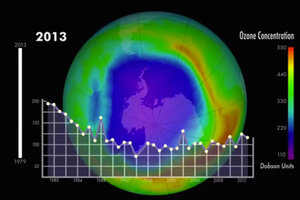Ozone layer on track to recover, UN says
A United Nations assessment of the ozone layer indicates that the layer of protective gas will largely return to 1980 concentrations by midcentury.

The minimum concentration of ozone in the Southern Hemisphere from 1979 to 2013. Each point represents the day with the lowest concentration that year.
M. Radcliff | NASA's Goddard Space Flight Center
Following a harrowing depletion in recent decades, Earth's protective ozone layer, high in the planet's atmosphere, is on the track to recovery, according to a new report released today (Sept. 10) at the United Nations headquarters in New York.
The evaluation, conducted by 282 scientists from 36 countries, credits much of this recovery to international action that phased out the production and use of ozone-depleting chemicals.
Since the last comprehensive ozone assessment in 2010, the use of most of these harmful substances has continued to drop, and the ozone may be on the path to recovery, according to the new report. [Earth in the Balance: 7 Crucial Tipping Points]
"There are telltale signs of ozone recovery in the upper part of the stratosphere," A.R. Ravishankara, a National Oceanic and Atmospheric Association (NOAA) emeritus scientist, professor at Colorado State University and co-chairman of the panel that prepared the report, said in a statement.
The ozone layer, located in Earth's stratosphere miles above the ground, shields the planet from much of the sun's damaging ultraviolet radiation. In the 1970s, researchers realized that gases such as chlorofluorocarbons (CFCs) and halons — which were commonly used in appliances such as refrigerators, spray cans, insulation foam and fire suppressants — led to the depletion of the ozone layer, NOAA researchers said. In 1985, the scientific community found a seasonal "ozone hole" over Antarctica, and spurred action to prevent its growth.
Starting in 1987, almost 200 countries joined together to ratify the Montreal Protocol, which is designed to phase out ozone-depleting substances, NOAA researchers said.
"There are positive indications that the ozone layer is on track to recovery towards the middle of the century," UN Under-Secretary-General and United Nations Environment Programme (UNEP) Executive Director Achim Steiner said in a statement. "The Montreal Protocol — one of the world's most successful environmental treaties — has protected the stratospheric ozone layer and avoided enhanced UV radiation reaching the Earth's surface."
If the Montreal Protocol had not passed, the use of ozone-depleting substances could have increased tenfold by 2050, UNEP officials said. Instead, by 2030, the protocol will have prevented an estimated 2 million cases of skin cancer annually, and will continue to protect wildlife and agriculture, according to the UNEP.
The new report also highlights the intricate links between the ozone layer's recovery and climate change, Ravishankara said. For instance, some chemicals that have replaced ozone-depleting substances are still potent greenhouse gases, which contribute to global warming.
To fight back, scientists from NOAA's Earth System Research Laboratory are testing potential substances that are safe for the ozone layer, climate and environment, experts said.
If countries continue to abide by the Montreal Protocol, ozone levels across the globe are expected to recover to 1980 concentrations before the year 2050, but the hole over the South Pole likely won't heal until 2070, Ravishankara said.
Researchers affiliated with the UNEP and the World Meteorological Organization (WMO) plan to keep a close eye on ozone levels in the years to come, WMO Secretary-General Michel Jarraud said in a statement.
"Human activities will continue to change the composition of the atmosphere," Jarraud said. "WMO's Global Atmosphere Watch program will, therefore, continue its crucial monitoring, research and assessment activities to provide scientific data needed to understand and ultimately predict environmental changes, as it has done for the past 25 years."
Researchers will present the report, dubbed the Scientific Assessment of Ozone Depletion 2014, in November, at the annual meeting of the Parties to the Montreal Protocol in Paris. The full report, which is expected to inform policymakers, will be published in early 2015.
Follow Laura Geggel on Twitter @LauraGeggel and Google+. Follow Live Science @livescience,Facebook & Google+. Original article on Live Science.
- Top 10 Ways to Destroy Earth
- 50 Interesting Facts About The Earth
- Images: One-of-a-Kind Places on Earth
Copyright 2014 LiveScience, a TechMediaNetwork company. All rights reserved. This material may not be published, broadcast, rewritten or redistributed.

